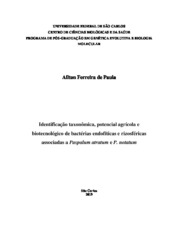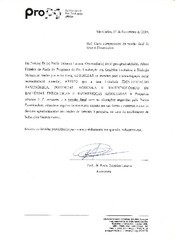| dc.contributor.author | Paula, Ailton Ferreira de | |
| dc.date.accessioned | 2019-12-04T14:20:57Z | |
| dc.date.available | 2019-12-04T14:20:57Z | |
| dc.date.issued | 2019-08-02 | |
| dc.identifier.citation | PAULA, Ailton Ferreira de. Identificação taxonômica, potencial agrícola e biotecnológico de bactérias endofíticas e rizosféricas associadas a Paspalum atratum e P. notatum. 2019. Tese (Doutorado em Genética Evolutiva e Biologia Molecular) – Universidade Federal de São Carlos, São Carlos, 2019. Disponível em: https://repositorio.ufscar.br/handle/ufscar/12109. | * |
| dc.identifier.uri | https://repositorio.ufscar.br/handle/ufscar/12109 | |
| dc.description.abstract | The genus Paspalum belongs to the family Poaceae and has several species native to Brazil. The Germplasm Bank of Paspalum of Embrapa Pecuária Sudeste has about 450 accessions of 50 species. Among the conserved accessions, two were chosen for this study: BGP 26 of P. notatum (potential as a lawn) and BGP 308 of P. atratum (potential as a forage ). To date, both endophytic and rhizospheric microbiological diversity for these two accessions were unknown, as well as the potential of these bacteria for promoting the plant growth (BPPG). The objective of this study was to evaluate the endophytic and rhizospheric bacterial community of P. atratum and P. notatum, in order to (1) identify in vitro the potential of these microorganisms in the promotion of plant growth by biological nitrogen fixation (BNF), phosphate solubilization (FS), indol-acetic acid (IAA) production and antagonistic ability. (2) Select the best isolates for the in vivo plant growth promotion test in the BGP 308 accession, with different phosphate sources treatments and no add of nitrogen in the soil. As for the in vitro tests, the BNF was tested in a nitrogen-free semi-solid culture medium, the FS was tested in nutrient agar medium supplemented with insoluble phosphate and the IAA was tested in the medium 10% Tryptin + L-tryptophan. In the antagonism test, Bipolaris sp. spores were streaked onto Potato Dextrose Agar agar medium and the bacterial isolate was inoculated onto the stria. In the molecular identification the 16S gene was used and the sequences were compared in the Classifier software. Eight isolates with potential for BNF, FS and IAA were in vivo evaluated in BGP 308. The soil was prepared with three sources of phosphate plus phosphate control without phosphate. The plants had the morphological descriptors measured and the dry matter was submitted to the near infrared spectrometer (NIRS) for chemical determination of each treatment. Analysis of variance, t-Test and Principal Component Analysis were generated in the Statistical Analysis System software. Two hundred and thirteen bacterial isolates (97 BGP 26 and 118 BGP 308) were purified. The total of 54 isolates presented potential for BFN, FS and IAA. These isolates were submitted to molecular identification and the antagonism test. Seven bacterial genera were found: Bacillus, Enterobacter, Microbacterium, Micrococcus, Pantoea, Pseudomonas and Rhizobium. The isolates 50 (Pseudomonas spp.) and 53 (Bacillus spp.) presented antagonistic activity against Bipolaris sp.. In the in vivo test the results showed BPPG, the most promising isolates were 103 (Enterobacter spp.), 110 (Enterobacter spp.) and 458 (Pseudomonas spp.). With this work, it was possible to know the bacterial community for the two accessions in question and to obtain new isolates with potential for Plant growth-promoting. | eng |
| dc.description.sponsorship | Coordenação de Aperfeiçoamento de Pessoal de Nível Superior (CAPES) | por |
| dc.language.iso | por | por |
| dc.publisher | Universidade Federal de São Carlos | por |
| dc.rights | Attribution 3.0 Brazil | * |
| dc.rights.uri | http://creativecommons.org/licenses/by/3.0/br/ | * |
| dc.subject | Solubilização de Fosfato | por |
| dc.subject | Fixação Biológica de Nitrogênio | por |
| dc.subject | Ácido Indol-acético | por |
| dc.subject | Phosphate solubilization | eng |
| dc.subject | Biological nitrogen fixation | eng |
| dc.subject | Indole-acetic acid | eng |
| dc.title | Identificação taxonômica, potencial agrícola e biotecnológico de bactérias endofíticas e rizosféricas associadas a Paspalum atratum e P. notatum | por |
| dc.title.alternative | Taxonomic identification, and agricultural biotechnological potential of endophytic and rhizospheric bacteria associated with Paspalum atratum and P. notatum | eng |
| dc.type | Tese | por |
| dc.contributor.advisor1 | Lacava, Paulo Teixeira | |
| dc.contributor.advisor1Lattes | http://lattes.cnpq.br/8947678349043750 | por |
| dc.contributor.advisor-co1 | Fávero, Alessandra Pereira | |
| dc.contributor.advisor-co1Lattes | http://lattes.cnpq.br/4329892306148506 | por |
| dc.description.resumo | O gênero Paspalum pertence à família Poaceae e possui várias espécies nativas do Brasil. O Banco Ativo de Germoplasma de Paspalum da Embrapa Pecuária Sudeste possui cerca de 450 acessos de 50 espécies. Dentre os acessos conservados, dois foram selecionados para este estudo: BGP 26 de P. notatum (potencial como planta de cobertura de solo) e BGP 308 de P. atratum (potencial como planta forrageira). Este trabalho teve por objetivo (1) estudar a comunidade bacteriana cultivável endofítica e rizosférica de P. atratum e P. notatum, visando identificar in vitro o potencial desses micro-organismos para a fixação biológica de nitrogênio (FBN), solubilização de fosfato (SF), produção de ácido indol-acético (AIA) e controle biológico por meio de antagonismo. (2) Selecionar os melhores isolados para o teste de promoção de crescimento vegetal in vivo no acesso BGP 308, com tratamentos em diferentes fontes de fosfato, sem correção de nitrogênio no solo. Quanto aos testes in vitro, a FBN foi testada em meio de cultura semi-sólido livre de nitrogênio, a SF foi testada em meio ágar nutriente suplementado com fosfato insolúvel e o AIA foi testado o meio Caldo Triptona de Soja 10% + L-triptofano. No teste de antagonismo, esporos de Bipolaris sp. foram estriados em placa contendo meio Potato Dextrose Agar e o isolado bacteriano foi inoculado sobre a estria. Na identificação molecular foi utilizado o gene 16S e as sequências foram comparadas no software Classifier. Foram selecionados oito isolados com potencial para a FBN, SF e AIA e avaliados in vivo em BGP 308. O solo foi preparado com três fontes diferentes de fosfato mais o controle sem fosfato. As plantas tiveram os descritores morfológicos medidos e a matéria seca foi submetida ao espectrômetro de infravermelho próximo (NIRS) e análise de micro e macronutrientes, para determinação química e nutritiva de cada tratamento. As análises de variância, Teste t e a Análise de Componentes Principais foram geradas no software Statistical Analysis System. Foram purificados 213 isolados bacterianos (97 de BGP 26 e 118 de BGP 308). Um total de 54 isolados apresentou potencial para FBN, SF e AIA. Esses isolados foram submetidos à identificação molecular e ao teste de antagonismo. Foram encontrados sete gêneros bacterianos: Bacillus, Enterobacter, Microbacterium, Micrococcus, Pantoea, Pseudomonas e Rhizobium. O isolado 50 (Pseudomonas spp.) e 53 (Bacillus spp.) apresentaram atividade antagonista contra Bipolaris sp.. No teste in vivo, os resultados mostraram que os isolados mais promissoras foram 103 (Enterobacter spp.), 110 (Enterobacter spp.) e 458 (Pseudomonas spp.). Com este trabalho, foi possível conhecer parte da comunidade bacteriana cultivável para os dois acessos em questão e obter novos isolados com potencial para a promoção de crescimento vegetal. | por |
| dc.publisher.initials | UFSCar | por |
| dc.publisher.program | Programa de Pós-Graduação em Genética Evolutiva e Biologia Molecular - PPGGEv | por |
| dc.subject.cnpq | CIENCIAS BIOLOGICAS::BIOQUIMICA::BIOLOGIA MOLECULAR | por |
| dc.subject.cnpq | CIENCIAS BIOLOGICAS::BIOQUIMICA::BIOQUIMICA DOS MICROORGANISMOS | por |
| dc.description.sponsorshipId | CAPES: código de financiamento - 001 | por |
| dc.publisher.address | Câmpus São Carlos | por |
| dc.contributor.authorlattes | http://lattes.cnpq.br/5214484171327849 | por |


